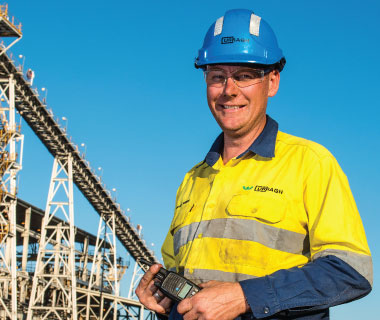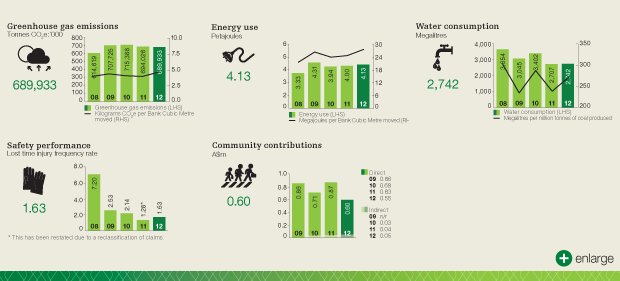Resources
At Curragh, sustainability initiatives address a range of issues including environment, people, economic, carbon and energy efficiency.
More Info
At Curragh, sustainability initiatives address a range of issues including environment, people, economic, carbon and energy efficiency.
More Info
We are a significant Australian open-cut miner and a leading metallurgical coal producer and supplier of thermal coal for domestic power generation. We operate the Curragh open cut coalmine near Blackwater in Queensland’s Bowen Basin and have a 40 per cent interest in the Bengalla mine in the Hunter Valley of New South Wales. The Bengalla mine is not covered in this report, as its performance is publicly reported by Rio Tinto Coal Australia. Wesfarmers divested the Premier Coal business on 30 December 2011, and this section of the report does not include Premier Coal data. However, material data from the period of ownership of Premier Coal is included in the Data Bank.
At 30 June 2012, we had 658 people permanently employed; 49 in the Resources divisional office and 609 at the Curragh mine operation. The total coal production for Curragh was 10.10 million tonnes, which was 29 per cent higher than in the previous year.

This year has seen a significant change for our business, with the sale and divestment of the Premier Coal operation and the major expansion of the Curragh mine. While these two activities have in many ways dominated the year, we have continued to consolidate and improve our sustainability performance.
As always, safety is the highest priority and this year we had a 42 per cent reduction in the total recordable injury frequency rate sustained by our Curragh employees and contractors. While this is a very pleasing result we will continue to focus on this important aspect of our business.
During the year, we also introduced initiatives to recognise our people for their innovations. We implemented a ‘Women in Resources’ program across the business and continued to progress our Aboriginal and Torres Strait Islander Employment Strategy. We also initiated a new community program with a focus on community health, we improved our water management at Curragh, and we prepared for the introduction of the Clean Energy Future legislative package.
We recognise the need to improve the gender balance in our workforce and to better reflect the communities in which we operate. This year, we launched our ‘Women in Resources’ program, which focuses on attracting women to our business while at the same time developing those women already within the business. The program includes one-on-one mentoring, self-paced study, discussion groups and participation in industry events and forums. Education and engagement of managers has also played a key role in achieving our objective of boosting the number of women in our workforce and in leadership roles.
Responding quickly and effectively to an emergency on-site is critical for Curragh given its relatively remote location and limited access to medical and hospital services. This year, Curragh has invested in further development of its own Emergency Response Team (ERT) by increasing its numbers from 12 in early 2011 to 43 in June 2012. In the event of an emergency, the ERT members augment the four full‑time contract Emergency Services Officers.
Along with the increase in number, the ERT upgraded its self-contained breathing apparatus and hydraulic cutting and spreading equipment. Through the provision of additional training, a number of ERT members achieved Certificate IV Industrial Paramedic and Certificate III Industrial Responder qualifications.
The ERT participated in the 2012 Australasian Road Rescue Competition in Hobart to test its skills against other emergency response teams. Our team performed well and importantly gained valuable experience and learning through this process.
Following the completion of initial training, in August 2011 10 Indigenous trainees started work at the Curragh mine, with four employed by Curragh and six by Thiess. This Indigenous employment initiative, in conjunction with The Salvation Army Employment Plus program, has proven to be very successful with all four of Curragh’s Indigenous trainees still involved with the program.
After successive above average wet seasons, water management at Curragh continues to be a major challenge. During the year, Curragh developed a site water balance model which is designed to assist in decision-making about site water inventory management and future water infrastructure investments. Along with this model, additional water release points into the McKenzie River were installed at Curragh North to assist in site water inventory management. As a result, 1,186 megalitres of excess water was released from the site in accordance with regulatory approvals.
Our focus at Curragh this year has been to undertake a significant project to determine the fugitive emissions associated with the coal mining process. This project has involved drilling and gas analysis to determine more precisely what the greenhouse gas emissions are. The outcome of this project will allow Curragh to more accurately report its fugitive emissions in 2012/13.
Once again significant dewatering was required at the Curragh mine as a legacy of the 2010/11 central Queensland floods. The discharge of water was conducted in accordance with the licensing arrangements approved by the Queensland Department of Environment and Heritage Protection. This dewatering program required significant additional energy to be used for non-mining related activities.
Our total direct (Scope 1 and 2) greenhouse gas emissions were 644,384 tonnes of CO2e, up 21.6 per cent on last year (excluding Premier Coal from the 2011 data). This change largely related to the major expansion project undertaken during the year that included the construction and commissioning of a new coal handling and preparation plant (CHPP).
Our main energy use during the year related primarily to the operation of our draglines, coal handling and preparation plant and diesel-operated equipment at Curragh. Total energy consumption was 4.13 petajoules, up 24.8 per cent on last year (excluding Premier Coal from the 2011 data). The increase in energy was largely related to the construction and commissioning of the new CHPP.
Since 2006 we have been a part of the Mines Medical Consortium, a private sector mining/government partnership to provide a second doctor in Blackwater. This partnership provides for enhanced medical treatment for employees, their families and the local community. This year Curragh expanded its support for local health through sponsorship of the central Queensland Whole of Practice Professional Activities Conference and the Queensland Institute for Medical Research, and support to the Blackwater Hospital.
A new initiative this year for the Brisbane office was the introduction of a matched-giving program. Donations were collected for employee-nominated local charities, with all donations matched by the business. This program resulted in more than $5,000 donated to organisations such as the 139 Club, Youngcare, Givit, Mental Illness Fellowship of Queensland and the Pony Riding for the Disabled Association as part of the McIntyre Centre.